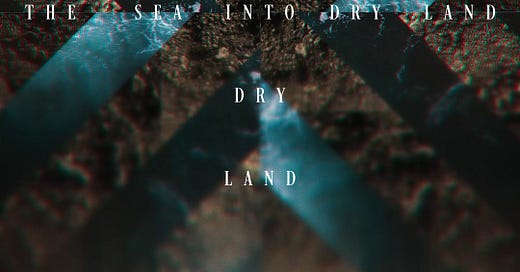Who turneth the sea into dry land, in the river they shall pass on foot: there shall we rejoice in him. (Psalm 65:6 DR)
One of the earliest and most difficult heresies that nascent Christianity was forced to confront was what is broadly referred to as Gnosticism. I say broadly as the various strands of Gnosticism were as vast as the number of their founders and were often contradictory in their theologies—such as they were—and the practical out-workings of those.
Gnosticism comes from the Greek root gnosis, meaning knowledge, and Gnosticism is often characterized—too broadly and unhelpfully, I think—as being having a sort of secret knowledge as what was constitutive of Gnosticism as a whole. I find this an unsatisfying definition for being overly broad, for while most Gnostic systems did assert some sort of secret knowledge for the initiated, such a characterization does not allow for meaningful distinctions within the myriad systems of Gnosticism. Rather, I think Gnosticism is more helpfully characterized as broadly being a system of emanations, by which the relation of God to the created world is articulated. It is these systems of emanations that create the necessary distinctions between the various sects and systems of gnosis, and are what are actually constitutive of that secret knowledge to which initiates were initiated and which set them apart as heretical from orthodox Christianity.
All that being said, one through-line of most—if not all—Gnostic systems was a rejection of the inherent goodness of the created order as a creation of God. In many systems of emanations it was an evil demiurge—who was a creation of the Father and who in pride or some other imperfection fell from grace—who was the actual creator of the physical, material universe. By virtue of this lesser being creating the world through his own imperfection, the material order was necessarily inherently evil, and many Gnostic systems outright rejected the Old Testament scriptures as they saw this Demiurge as the God of the Old Testament.
However, this rejection of the material order as inherently evil and of the Old Testament Scriptures as the product of an evil demiurge, also led to a de facto rejection of the New Testament in terms of what it posits of Christ in the Incarnation and His Passion, Death and Resurrection. For if the material universe is inherently evil, so are the material bodies of men. Thus, our Lord in this conception could not have assumed a human nature unto Himself without becoming evil Himself. Due to this many Gnostic systems posited that His body was merely a phantom or some kind of flesh puppet that He controlled. The notion of the laughing Christ is a common one in early Gnostic systems such as Doceticm, which have the material flesh puppet of Christ dying on the cross, while the actual Christ laughs at those who think they are killing Him. We probably see early versions of these Gnostic fantasies rejected in the New Testament writing directly, such as in 1 John where the apostle castigates those who deny that our Lord has come in the flesh.
It was this discomfort with the physical world—which Gnostic thought received from some versions of Greek philosophy—that led them to reject much of the Scriptures and even the Incarnation. To explain the world as it is in light of this assumption then required complex systems of emanations to distance the pure eternal Father from the evil of the physical world, yet still be able to bring about some sort of redemption for the souls (but not bodies!) of the initiated.
The Catholic Church, on the other hand, maintained from the beginning that Christ had truly come in the flesh, that the Word truly became flesh and dwelt among us, and that the good world that God had created—though corrupted by sin (cf. Romans 8:19-23)—would one day be redeemed. This included the scandalous notion of the resurrection of the body, which was often met with scoffs and mockery (cf. Acts 17:32). Yet this truth forms the basis of salvation and is the philosophical underpinning of Catholic anthropology on which man is not merely a soul inhabiting a body but a body and soul composite; in other words, the human soul is not complete, as it were, without its body, as that soul is the form of the body.
And since God created us in this manner, He also redeems us in this manner, which is why He provided the Sacraments which are physical signs of grace. And while that grace is not a physical thing, it is accomplished by means of these physical signs; hence in Baptism, for example, the grace of the remission and cleansing of sin is effected by the physical washing of water. The Sacrament of the Eucharist not only is the physical sign of bread and wine, but in the consecration becomes the physical body and blood of our Lord Jesus Christ united to His soul and divinity; in other, the whole and entire Christ.
The physical realism of Christianity thus sets it apart from the systems of emanations like Gnosticism, whether in the ancient world or in modern instantiations that perhaps have less flamboyant cosmologies, yet still reject to some extent or another the teaching of the Catholic Church and of Christian orthodoxy by de facto rejecting sacramental realism as in that the sacraments actually effect what they signify.
As we come to this passage in this Psalm, the Psalmist has concluded his introduction in which he offered a series of imperatives to praise the Lord and to sing a Psalm unto His name. These case for these imperatives—so to speak—was then introduced by him saying Come and see the works of God. This serves as a preamble of sorts in which these works of God will be delineated.
For the Psalmist, God is not an abstraction or a theological system to be contemplated and Who should be praised merely for the grandeur of His philosophical attributes or perfections; rather, the proof of God’s greatness is seen in His acts in history. God does not stand aloof from the world as if contact with the world would sully His holiness; instead, He acts in history on behalf of His people, to save them, correct them, and ultimately to redeem them. These acts of God in history—which are historical and literal fact—also serve as prophetic signs of the coming of our Lord Jesus Christ in the flesh, and the establishment of His Church and the Sacraments which He initiated for our salvation.
The Psalmist proceeds to elaborate on this history, and in the first passage says: Who turneth the sea into dry land, in the river they shall pass on foot: there shall we rejoice in him. These allusions are to the crossing of the Red Sea when Moses delivered the people of Israel from Egypt (cf. Exodus 14) and the crossing of the Jordan River when Joshua led the Israelites into the Promised Land (cf. Joshua 3). Although Moses and Joshua led the people in these instances—stories which would have been well familiar to the Psalmist’s hearers—it is if course God who effects the miracles, it is He Who turneth the sea into dry land. It is this redemption through water that then forms the culmination of the passage: there we shall rejoice in Him.
There is perhaps a bit of an ambiguity here, for the word there doesn’t seem to have an expected antecedent. In the narratives the people pass through the water out of Egypt and into the Promised Land, respectively, and it would seem to be this that would be the natural understanding of there. Perhaps the Psalmist means this by implication; that is, in the Promised Land—there we shall rejoice in Him.
St. Bellarmine notices an interesting shift of tense which lends some weight to this reading:
There shall we rejoice in him; where those things have been done; there we have rejoiced in him, not taking any credit to ourselves as if they were our acts, but rejoicing and glorying in God, and have praised him, as may be seen in Exodus 15 and Joshua 3.
The prophet uses the future for the past, unless, perhaps, he meant to insinuate that these miracles would be succeeded by much greater ones, of which they were only the types and figures. A much greater miracle is that men should pass over the bitter sea of this life, and cross the river of mortality, that never ceases to run, and which swallow up and drown so many; and still come safe and alive to the land of eternal promise, and there rejoice in God himself, beholding him face to face; and yet this greater miracle is so accomplished by God, that many pass through this sea as if it were dry land, and cross this river with dry feet; that is to say, having no difficulty in despising all things temporal, be they good or be they bad; that is to say, being neither attached to the good things, nor fearing the evil things of this world, that they may arrive in security at the heavenly Jerusalem, where we will rejoice in him, not in hope, but in complete possession, for eternity. (St. Robert Bellarmine, A Commentary on the Book of the Psalms, 65, 6.)
St. Robert Bellarmine follows St. Augustine here, who, while not rejecting by any means the historical and literal meaning, nevertheless sees a prophetic intimation of the greatness of salvation to be accomplished in our Lord Jesus Christ:
A sea was the world, bitter with saltness, troubled with tempest, raging with waves of persecutions, sea it was: truly into dry land the sea has been turned, now there thirsts for sweet water the world that with salt water was filled. Who has done this? He that has turned the sea into dry land. Now the soul of all the Gentiles says what? My soul is as it were land without water to You. That has turned the sea into dry land. In the river they shall pass over on foot. Those same persons that have been turned into dry land, though they were before sea, in the river on foot shall pass over. What is the river? The river is all the mortality of the world. Observe a river: some things come and pass by, other things that are to pass by do succeed. Is it not thus with the water of a river, that from earth springs and flows? Every one that is born must needs give place to one going to be born: and all this order of things rolling along is a kind of river. Into this river let not the soul greedily throw herself, let her not throw herself, but let her stand still. And how shall she pass over the pleasures of things doomed to perish? Let her believe in Christ, and she will pass over on foot: she passes over with Him for Leader, on foot she passes over. (St. Augustine, Expositions on the Psalms, 65, 11.)
The passions and temptations of this world and the passing of time are certainly well-likened to the raging seas and moving rivers, and St. Augustine well notes that their ever-changing and temporal nature is much like the goods and pleasures of this world which clamor for our attention and love but which are here today and gone tomorrow. Only Christ can lead us through on dry land—that is—in sobriety and temperance and virtue, leading us to walk in the way He walked, willing to take up our crosses and mortify our sinful nature and flesh with its passions.
However, there may be a deeper (pun intended) meaning to these waters. Since the waters are the means by which they passed out of Egypt and into the Promised Land, these waters then stand in—in a sense—for the means of their salvation; it is, after all, how God brings His people out of bondage and into the land He promised to Abraham. These waters themselves may in fact be the antecedent to there, for it is in these means of salvation that they shall rejoice in Him:
This is the God Who will grant us salvation as well, Who of old divided sea and river, and bade our forbears cross without risk and accords the nations the crossing that they make when through the washing of regeneration they are reformed. In other words, just as at that time through the hand of mighty Moses He divided the Red Sea at this point… so now as well through the hand of the priests He renews the people who believe in Christ, while submerging the figure of Pharaoh with his chariots—that is, the devil with his desires. (Theodoret of Cyr, Commentary on the Psalms, 65.4, ACCS.)
In Baptism the stain of original sin is washed away and we are filled with the charity of God through the outpouring of the Holy Ghost (cf. Romans 5:5). This is the promise Jesus spoke of:
But the water that I will give him, shall become in him a fountain of water, springing up into life everlasting. (John 4:14 DR)
St. Augustine is fond of speaking of how the veil of Christ’s flesh was pierced on the Cross and the Sacraments came flowing forth; these Sacraments initiate and confirm and conform us into the life and love of God. God uses the literal waters of this world to overcome in us the tumult of the seas and rivers of our passions and sins, and in turn pours His charity as a fountain of living water into our souls. As we are united to Christ in His mystical Body as the branch is to the vine, or—in keeping with this metaphor—as the spring to the fountain or the fountain to the aquifer—we partake of His life and His divinity (cf. 2 Peter 1:4). As the Psalmist elsewhere says:
Et cantores quasi in choris: omnes fontes mei in te.
And the singers as it were in choirs: all my fountains are in You. (Psalm 86:7, St. Jerome’s Hebrew translation.)
The same fountains of water which flowed from the side of Christ on the cross and renew men unto salvation in the sacrament of Baptism, and spring up in his soul through the outpouring of the Holy Ghost, continue on into eternity in the New Jerusalem, for from that same source issue forth the waters of life:
And he shewed me a river of water of life, clear as crystal, proceeding from the throne of God and of the Lamb. In the midst of the street thereof, and on both sides of the river, was the tree of life, bearing twelve fruits, yielding its fruits every month, and the leaves of the tree were for the healing of the nations. And there shall be no curse any more; but the throne of God and of the Lamb shall be in it, and his servants shall serve him.
And the spirit and the bride say: Come. And he that heareth, let him say: Come. And he that thirsteth, let him come: and he that will, let him take the water of life, freely. (Apocalypse 22:1-3, 17 DR)
I found two images—one of water and one of dry ground—and precomped each. I applied Wave Warp to the top layer, changing the type to Square and adjusting the size so the bottom image showed through the strips.
Next I applied CC Kaleida to an Adjustment Layer and rotated the effect. I finally added in some color correctio and camera blur on the edges.
Enjoy.
Who turneth the sea into dry land, in the river they shall pass on foot: there shall we rejoice in him.
(Psalm 65:6 DR)
View a higher quality version of this gif here:












Share this post